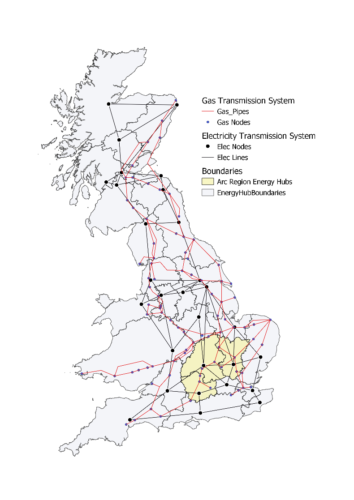This research was funded by a grant from the UK Engineering and Physical Science Research Council to the ITRC
Research question & scope
The energy supply model is utilised to evaluate how different low-carbon local energy supply strategies could affordably reduce carbon emissions from the Oxford-Cambridge arc’s energy system given ambitious future growth scenarios. The local energy supply strategies were chosen so that they cover a range of technology options across the arc region to decarbonise heat supply, these range from electrification to use of green gases (hydrogen and biogas) and local heat network solutions.
Methodology
The Energy Demand and Transport models were used to calculate heating and non-heating energy demands, including the demand for transport using the growth assumptions for population, additional dwellings and GVA for the Arc Scenarios. The energy demands were used as inputs to the Energy Supply model.
The Energy Supply model’s Energy Hub representation of local energy systems were used to characterise energy supply systems within the Oxford-Cambridge Arc region (Figure 1, yellow area). The technology uptake across the energy supply strategies, considered key elements such as maturity, annual build rates, annual and peak heat demand, and capacity margins.

Figure 1: The Oxford Cambridge arc region represented by energy hub regions in the Energy Supply Model
Operational analysis was performed on the GB energy system (transmission and all energy hubs) across arc scenarios and energy supply strategies for simulated years (2015, 2030, 2050) which consisted of four seasons. Each season was modelled by a representative week using hourly time granularity.
Results
Interactive power BI report : https://app.powerbi.com/view?r=eyJrIjoiZGMzZWZmYTctMmViNS00OWVjLWFhYjQtNThhMTJjNmJjOTljIiwidCI6ImJkYjc0YjMwLTk1NjgtNDg1Ni1iZGJmLTA2NzU5Nzc4ZmNiYyIsImMiOjh9
Key findings
- There are different ways in which the goals of a carbon-neutral Arc (for energy supply and buildings) can be achieved.
- Consistent with the UK’s current energy policies, we assume that electricity supplied by the national electricity transmission system will be near zero carbon by the 2030s.
- Utilising EV vehicle to grid services could generate up-to 25% of the Arc’s electricity needs by 2050 during peak periods.
- Local renewables contributed up-to 15% of the Arc’s electricity needs in 2050, primarily from photo-voltaic (PV) panels.
- EVs, local renewables and CHP units connected to heat networks suppled up-to to 66% of the Arcs electricity requirements in 2050.
- The national electricity transmission system would still be required to provide backup. In 2050, this ranged from 60% of overall electricity supplies in electric based ARC strategies to 30% where heat networks are prevalent.
- Gas use decreases by at least 90% in 2050 compared with 2015 in heat electrification strategies across all scenarios.
- Eliminating carbon emissions from heating systems will be much more disruptive than decarbonising existing electricity supplies, which can be more or less ‘invisible’ to the consumer. Nonetheless, electrification of heating in the ARC region by utilising heat pumps, resistive heating and electric boilers, and running these on decarbonised electricity can cost-effectively reduce residential and commercial emissions to near zero.
- An electric heating strategy and rapid uptake of electric vehicles doubles the annual and peak electricity demand in 2050 (compared to 2015), requiring significant additional generating and electrical network capacity.
- Demand for electricity (including for heating) could be reduced by 7% relative to a ‘business as usual’ building scenario through the adoption of energy efficiency and insulation solutions.
- Implementation of Demand Side Management (DSM) solutions illustrated the possibility of shifting up-to 1GW peak electricity demand to off-peak periods.
Impact
The collaboration provided integrated analyses across energy systems (national and local), energy demand (demand types, sources, technologies, and sectors – residential/commercial etc) and transport (EVs, Hybrids etc).
Detailed assumptions from the transport model (EV trips, time of trips, vehicle engine types, battery capacity etc) facilitated modelling of energy demand for transport and allowed the utilisation of EV batteries for V2G services to be investigated.
What’s next
We will look to collaborate with governmental entities (Ofgem, BEIS, NIC and CCC) on integrated analyses across energy, transport and water systems, regionally, nationally (UK), and internationally.
Institutions:
- Energy Supply – Cardiff University
- Energy Demand – University of Oxford
- Transport – University of Southampton


